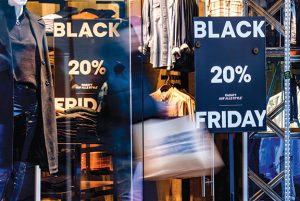Bloomberg
US retailers discounted heavily on Black Friday to clear out bloated inventories but customers responded with only modest traffic, leaving profitability in doubt for many chains.
Crowds were thin at Connecticut’s Stamford Town Center mall, with few shoppers at Kay Jewelers and just a small line at Forever 21. A couple at a Walmart Inc supercenter near Dallas reveled in the lack of crowds as they bought presents for their grandchildren. At the Stonestown mall in San Francisco, shoppers were few and far
between.
“It feels like a normal day,†said Miguel Martinez, 35, a warehouse supervisor walking through a Target Corp store on Chicago’s North Side with his 12-year-old daughter, Jaylen. Martinez said he’s been cutting back on cable TV and Netflix to afford presents for his four children. He described the Black Friday discounts as “pretty good†as he picked up a couple of Amazon Echo Dot speakers and a Disney Encanto doll.
Brick-and-mortar retailers, which were hit hard by Covid-19 closures and shoppers seeking to avoid the virus, saw in-store traffic tick up 2.9% this Black Friday compared to 2021, according to preliminary data compiled by Sensormatic Solutions.
US consumers are still spending, but they’re growing more cautious after contending this year with the highest inflation rates in four decades.
They’re also keeping a sharper lookout for deals, and retailers — many of them still heavy with inventory after misjudging an erosion in demand — are trying to stand out by dangling the deepest discounts since before the pandemic.
Modest Growth
The US holiday shopping season is likely to see modest to break-even growth in annual sales, said Melissa Minkow, director of retail strategy at digital consultancy CI&T. “That’s still a win,†she said, contrasting the outlook with the UK, where high inflation has caused consumers to pull back noticeably on spending. Still, the steep Black Friday discounts are likely to squeeze retailers.
“Profits will not be where retailers want them to be,†Minkow said. That’s in part because they “couldn’t pass all
of the inflationary costs off to consumers.â€
That’s far less than the US inflation rate of almost 8% during the 12 months ended in October. Salesforce Inc said the average consumer discount on Black Friday was expected to be greater than 30%, up from 28% last year and close to the 33% rate in 2019. The biggest discounts were in home appliances, apparel and health and beauty.
Shoppers are cutting back in reaction to higher prices, said Rob Garf, Salesforce’s vice president of retail. “People are just plainly buying less products because their dollar isn’t going as far as it used to,†Garf said.
 The Gulf Time Newspaper One of the finest business newspapers in the UAE brought to you by our professional writers and editors.
The Gulf Time Newspaper One of the finest business newspapers in the UAE brought to you by our professional writers and editors.
